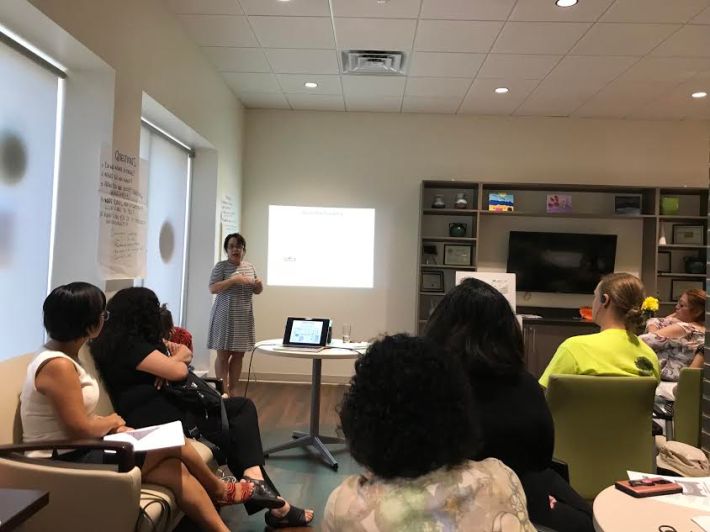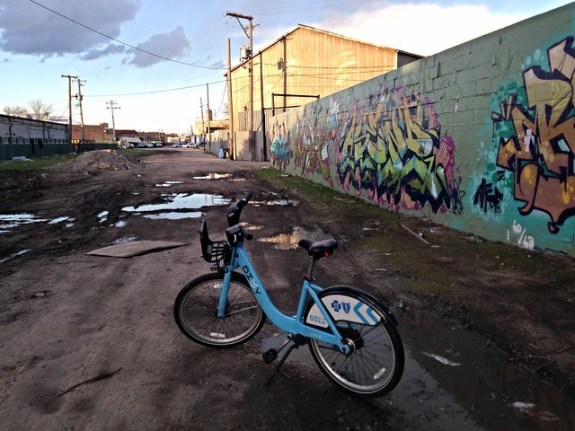On Tuesday, August 13, Little Village residents gathered at Oak Street Health on 26th Street for a community meeting on the proposed four-mile Paseo trail connecting Little Village and Pilsen. The event was hosted by Únete La Villita, the community development committee of Little Village. The proposed Paseo trail has been subject of extensive speculation and worry for residents, particularly regarding housing prices and displacement.
In February of this year, Únete put a referendum on the electoral ballot that asked residents in the 12th Ward in Little Village whether they wanted a community benefits agreement for El Paseo to maintain affordable housing. Over 80 percent of respondents voted yes.
To kick things off, Fanny Diego Alvarez, co-treasurer of Únete, offered opening remarks and introduced Juanita Irizarry, executive director of Friends of the Parks. The entire meeting was conducted in Spanish with translation provided as needed.
Irizarry, a long-time resident of Humboldt Park shared perspectives and lessons regarding the building of the Bloomingdale Trail, aka The 606, which has become a cautionary tale about how new recreational amenities can contribute to rising housing costs. According to a 2016 report by the Institute for Housing Studies at DePaul University, single-family home prices had increased 48.2 percent since the 606’s groundbreaking in the third quarter of 2013. Residents in Little Village want to know what can be done to prevent any such negative impacts from the Paseo.
Irizarry spoke of her own upbringing in Humboldt Park and how this issue is personal for her. She was living near the Humoldt Park green space when her landlord raised her rent by $450 and she had to move further west.
Irizarry said the idea for a trail on the old BNSF railroad right-of-way had been discussed for over a decade in the community, but once Mayor Rahm Emanuel made it a priority, funding started to flow in for the project. Irizarry said Emanuel’s involvement in the project changed what it had originally represented. “Mayor Rahm Emanuel said, and this is no secret, that a big part of his idea behind the trail was to raise property values to garner more of a tax base for the city,” Irizarry said. She added that if the idea of a new amenity starts with a desire to raise property taxes, we can’t be surprised when this happens.
An audience member asked whether there are any examples of green projects and trails that didn’t gentrify communities. “Everyone is talking about this in the world of parks nationwide, the issue of gentrification and the development of parks, even though there haven’t been a lot of solutions,” Irizarry responded. “They are talking about community control and how to have a process to include the community.”
The last audience member asked what we can learn from The 606 and its impacts. Irizarry said Chicago's new housing commissioner Marisa Novara, who previously researched local segregation issues at the Metropolitan Planning Council, can be a potential ally for community residents wanting to discuss how to get affordable housing built alongside new recreation amenities.

The next presenters were Nancy Meza and Jose Acosta of the Little Village Environmental Justice Organization. They discussed the background of the Paseo and the environmental context of the neighborhood. Meza described how the Paseo originated from the 2005-2006 Pilsen Quality Of Life Plan (similarly to how The 606 being based on a community plan). According to Meza, LVEJO originally came up with the idea for this trail. LVEJO was originally excited about the plan, particularly the possibility of connecting other green space in Little Village to their garden.
“The city’s idea to connect Pilsen and Little Village was when we took a step back,” Meza said. “We weren’t sure how they were trying to connect the two neighborhoods, particularly because of Western Avenue, which is a busy street with heavy diesel truck traffic.”
Though the Paseo has been approved, construction has not started in Little Village. BNSF still owns a significant amount of land next to the trail as well. A key difference between The 606 Trail and the Paseo Trail is that while the former is elevated, the latter would be at street level.
An audience member asked whether the city has evaluated the potential environmental impacts of the Paseo. “It’s difficult because the city of Chicago does not [currently] have a department of the environment,” Meza said. “So those kinds of studies have to be demanded from the community.”
Acosta talked about the Little Village Industrial Corridor, noting that the Chicago Sanitary and Ship Canal runs through the district which is particularly important in considering environmental impacts.
Last May, the Chicago Department of Planning and Development launched the Little Village Framework Plan to “review and enhance the Little Village Industrial Corridor.” Meza pointed out that when industrial corridors were created in Chicago, environmental and health concerns weren’t considered. Due to the lack of environmental consideration, Meza says, schools like Little Village Lawndale High School and Zapata Elementary School are located within an industrial corridor in Little Village, in addition to homes being right next to it.
“The city wanted recommendations regarding how to improve the industrial corridor,” Meza said. “But at community meetings this year, the city didn’t even know basic answers to questions as to how many businesses there are in the corridor.”
Meza said Little Village youth have been walking the corridor this summer to count the number and type of businesses within it. Acosta brought up the seeming contradiction of maintaining the canal for industry while opening the waterway for recreation, bringing up the recent push for creating a continuous riverwalk. “Again, we are seeing, with this recent process from the city, contradictory efforts. On one hand, you have the city trying to expand industry and on the other hand, they’re telling us to come to the river to recreate,” he said.
Acosta added that Little Village has the 2nd worst air quality in the Illinois, which has big implications when considering whether to build a recreational trail through the neighborhood.
Meza underlined the importance of addressing the heavy truck traffic that passes through Little Village, a core issue in considering what recreation will look like among pollutants. “It’s not like we don’t want new trails, but I also don’t want to get sick when I go for a run,” she said.
During the Q & A portion of the event, many residents expressed concerned about the Paseo moving forward amid big environmental questions and what they said was an opaque planning process with insufficient community input. A few seemed more receptive to the trail because it would bring more attention and amenities to the neighborhood, but othr saw that as fueling gentrification.
With the timeline for the project unclear, residents feel there is an opportunity to have more of a say in this process and help shape whether the Paseo becomes an amenity for current residents, or rather tool for raising property tax revenue that leads to displacement.




